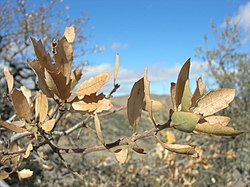| Tucker's oak | |
|---|---|
 | |
| Scientific classification | |
| Kingdom: | Plantae |
| Clade: | Tracheophytes |
| Clade: | Angiosperms |
| Clade: | Eudicots |
| Clade: | Rosids |
| Order: | Fagales |
| Family: | Fagaceae |
| Genus: | Quercus |
| Subgenus: | Quercus subg. Quercus |
| Section: | Quercus sect. Quercus |
| Species: | Q. john-tuckeri |
| Binomial name | |
| Quercus john-tuckeri | |
| Synonyms [2] | |
| |
Quercus john-tuckeri is a North American species of oak known by the common name Tucker oak, or Tucker's oak. [3] It is endemic to California, where it grows in the chaparral and oak woodlands of mountain slopes in the western Transverse Ranges, the southernmost Central Coast Ranges, and the margins of the Mojave Desert. [4] The species is named after John M. Tucker, professor of botany (1947–1986) at the University of California at Davis, specialist in Quercus. [3]
